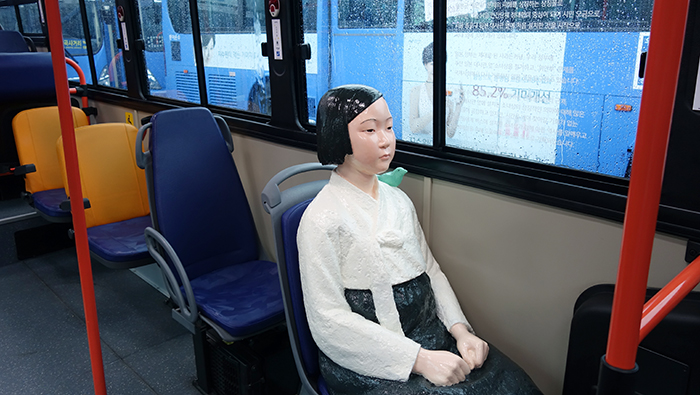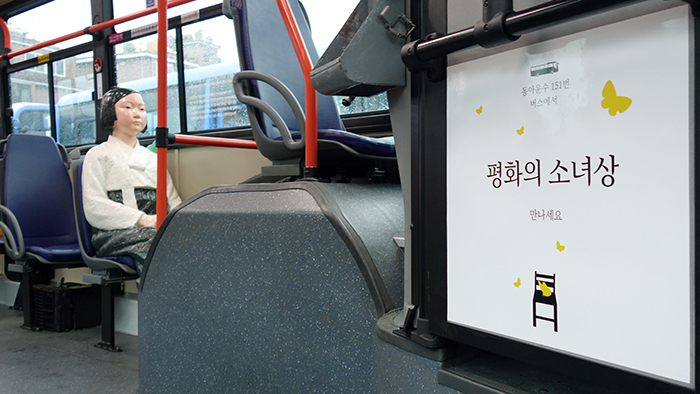
The Statue of Peace, symbolizing the women who suffered as sex slaves during colonial times and World War II, rides bus No. 151 around central Seoul on Aug. 14, to commemorate International 'Comfort Women' Day. The statue will continue to be installed on the bus for 45 days.
By Kang Gahui and Lee Hana
Photos = Kang Gahui
Seoul | Aug. 14, 2017
A barefoot young woman dressed in black-and-white Hanbok sits in a bus seat, two rows back from the front. People boarding the bus don't take much notice at first, but retrace their steps to do a double take at the statue and to read the writing on the window beside her. Some approach her immediately to take a selfie by her side. This girl, with her resolute expression and fists held tight, is the Statue of Peace, a symbol of the women who suffered as sexual slaves during colonial times and World War II.
On Aug. 14, five of Seoul's city buses began operation with these statues seated by the window, to pay tribute to them on International "Comfort Women" Day.
Seated on the No. 151 bus, the women met with passengers along the route that begins in the neighborhood of Ui-dong in Gangbuk-gu District and winds its way through Anguk Station and Sungnyemun Gate all the way to the neighborhood of Heukseok-dong in Dongjak-gu District, south of the Hangang River.
Passengers on the No. 151 who unexpectedly shared their commute with the Statue of Peace gazed at the woman in awe.
Kang Hee Moon, an office worker who sat in a seat across from the statue, remarked that riding in the same bus made the statue seem like a real person, whose grief she could feel directly. A fifth grade student, Lee Jae Seo, said, "It makes me fearful to think that such a young girl was taken away during times of war," and held her mother's outstretched hand.
When the bus passed Anguk Station near the Japanese Embassy in Korea, the song "Arirang," a new version of the song from the 2016 film "Spirits' Homecoming" (귀향), could be heard over the speakers. Listening to the tune, 73-year-old Lee Hee Jung said, "I hope that more people will take an interest in the women who suffered as sex slaves during the war. I'm also hopeful that the issue will be properly resolved soon."

The Statue of Peace sits near the front of bus No. 151. For this installation art project, the handrails on these buses have been equipped with near-field communication (NFC) devices that can be tapped with a smartphone to access information about the 'comfort women' issue.
Rim Jinwook, the CEO of Dong-a Traffic Service and the mastermind behind this installation art piece, said that he hopes the project will make passengers think more carefully about the sex slave victims from colonial times and Word War II. Saying that he chose the No. 151 route because it's a line that passes by seven of Seoul's major institutions of higher learning, including Duksung Women's University, Hansung University and Sookmyung Women's University. Rim stressed that, "Students should strive to have historical awareness and learn the correct facts."
Previously, Rim has supported projects such as the Tayo Buses to entertain young children, the Talking Buses for the visually impaired and the Pink Seats for pregnant women on public transportation. This current project was personally funded by Rim. Kim Seo-kyung and Kim Eun-sung, the sculptors who created the original Statue of Peace that sits by the Japanese Embassy in Korea, volunteered their services for the initiative.
The bus No. 151 project will run until Sept. 30. Thereafter, the Statues of Peace will be sent to Busan, Jeonju, Mokpo and Daegu where they will be "sent home" to sit alongside other women statues at each respective location.
kgh89@korea.kr